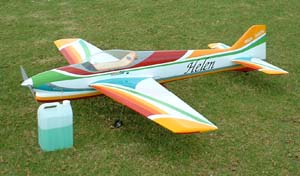Pass the Remote
That is, the remote control for my “RC” airplane

That is, the remote control for my "RC" airplane (it actually stands for radio controlled). The first time I watched this video of Belgian armchair pilot extraordinaire Benoit Dierickx (who flies 737s for a living) putting a super-light model F3A aerobatic airplane through its paces inside a gymnasium, I found myself tugged by competing emotions. I couldn't take my eyes off the aerobatic whirling dervish, though the soundtrack was rather cheese-laden (recognizable as the 1962 Quincy Jones big band arrangement "Soul Bossa Nova" off my Cocktail Mix Vol. 2: Martini Madness disc, and subsequently revived in Austin Powers films). I also wondered if Benoit ever gets bored after the 983rd snap roll—this thought from someone who has never flown his own RC airplane, but plans to get way into it in retirement (if that concept still exists for my 40-something generation).
When I was a painfully bored 7-year-old at Sunday mass, I used to imagine doing precisely Benoit's routine with an RC airplane inside the church, with a perfect landing down the center aisle as the sermon ended.
I emailed the video to colleagues and got mixed reactions. Some thought it was cool. Others wondered, as I did, if it qualified as, shall we say, a niche hobby, like synchronized swimming. But who am I to snicker? It's serious enough to these guys, who travel to F3A competitions across Europe all year, including the 2008 European Championship during the last week of August in Calcinatello di Calcinato, Italy. I don't know where that is, but if it's a sooty rail yard outside Milan, it sounds more exotic than wherever I was that week. Wildwood, New Jersey?
The F3A planes may be light—this one, made of balsa wood covered with plastic film, weighs just over 17 ounces—but they're relatively large, so you can only imagine how light these little guys are.
And the FAI (Federation Aeronautique Internationale), the global umbrella organization for all things aeronautic, has a page describing the various aeromodeling categories such as F1 (free flight), F2 (control line), etc. You can't deny that the F3A planes are about as maneuverable as anything in the air. Check out this routine by Gernot Bruckmann in a smaller gym. Next up: a phone booth.
Here's something else I hadn't seen. Sort of a version of slope soaring where the guy becomes the substitute for a landmass, and has to keep moving forward with his placard to create the effect of wind under his tiny glider. Not sure from this video how long he intends to keep this up. Seems there's a curious little culture around indoor, mini-soaring. They look like a breathless mom following a toddler who just learned to walk.
For my money, the really cool hobby deals in flying replicas of the big jets, such as this RC version of a C-17 Globemaster that flies like a high performance fighter. Or here's how an Airbus A380 might fly with afterburners. And who said the Concorde's grounded? Nothing's ever grounded, or impossible, in the RC world.